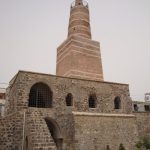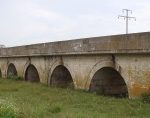When you’re researching a travel article everything sometimes works out perfectly first time round. Unfortunately on other occasions it simply doesn’t, which is how it was with me and Nusaybin. The first time I’d gone there some five or six years ago I might as well have stayed at home for all the good it did me. I’d bused there from Mardin with a friend who was working for the UN in Damascus and wanted to cross the border to Qamishli to catch a flight home. Unfortunately neither of us had thought to check the opening hours of the border crossing and so we arrived to find it closed. At that time there were only two small and not especially exciting hotels in town and both were full. We were forced to take up a taxi driver’s offer to run us out of town to the Nezirhan Hotel, then collect us in the morning, drop Lisa at the border and leave me in front of the monastery of Mor Yakup, the only tourist attraction in town.
The first part of that plan went swingingly and I was soon waving my friend on her way. But at the monastery the gates were firmly locked and there was nothing to suggest they would be opening again any time soon. I idled away a bit of time admiring the extraordinary new Mesopotamian Cultural Centre (Mitanni Kültür Merkezi) which was then under construction but already looked as if it would be more impressive than almost any new building I could think of. It was the carvings that did it – fine carvings of spread-winged creatures and men wearing hooped ear-rings that reminded me of ancient sculptures in the British Museum. Where, I wondered, had the money come from to pay for such extravagance in such an out-of-the-way place? Sadly, there was nothing to tell me the answer and I returned to Mardin not a whole lot wiser than I’d left it.
But that magnificent building in the making stuck in my mind and I’d always wanted to see the finished version. So last year while in Midyat I hopped on the dolmuş and headed south to a border which was at that time – not so very long ago although it now feels like ancient history – going great guns as a result of Foreign Minister Ahmet Davutoğlu’s “zero problems with neighbours” policy.
This time I was more hopeful. The monastery was now conspicuously signposted in half a dozen languages which suggested that once I found it I might even be able to get inside it. An archaeological dig was taking place beside it, slowly uncovering the remains of what may have been the very first university on Turkish soil, albeit one where a heretical form of Christianity known as Nestorianism was taught. Unfortunately I made the mistake of lingering to inspect the work in progress which meant that by the time I reached the actual entrance it was 12.05. Two Turkish tourists were glumly reading the sign that informed us that the opening hours included an hour’s closure for lunch extending from noon to 1pm. We exchanged notes on a new hotel in town (the Bulvar Palas), then went our separate, disappointed ways.
Actually though this hiccough turned out to be no bad thing, because it meant that I wandered about a bit and stumbled upon the flashy new Nu Cafe, a place so trendy it wouldn’t have looked out of place on İstiklal Caddesi. The decor was bright orange which was surprising enough in such a generally drab town but what was even more unexpected was that it revolved around images of the tribal people and wild animals of Africa in a country which often tends to act as if the outside world doesn’t exist. Needless to say, I was the only Westerner in there and the waitress came rushing to take my order before creeping shyly back to proffer a local guidebook.
With that in hand I found the hour before the monastery would reopen slipping by quite nicely, so it was irritating to return at 1.10pm and find the gate still locked. Beside it was a bell which I rang and rang until eventually a child emerged at the top of a flight of stairs at the back of the monastery to tell me that her father was out which meant that the monastery would be staying shut.
Rapidly losing my cool at the prospect of a third visit just to tick off this one sight, I stomped back to the cafe and found a small shop nearby. “Do you know where the monastery caretaker is?” I asked its startled owner.
“He should be there,” he told me. “It opens at 1pm.” There then ensued some very Turkish toing and froing on the phone in a desperate attempt to solve the embarrassing problem of a visitor who’s arrived to see the local tourist attraction and found no one around to show it to them. Things were not looking good, though, and I was starting to tire of perching uncomfortably on a vat of something liquid and running through my life history with a succession of curious customers when at last more encouraging words were spoken. The Vali (Governor) had arrived from Mardin and he too wanted to see the monastery. The Kaymakam was with him there now. If I rushed I would be able to infiltrate their group.
Outside the monastery official black limos now stood in line and, sure enough, the gate was suddenly open. I slipped hastily through it and insinuated myself at the back of the group beside a security attachment that was already showing signs of being ready to move on. But what a joy it was to see inside that monastery at last! From the outside it’s a building of almost ferocious austerity, a hefty rectangular block of masonry whose only decorative feature is a string of arches, filled-in at a later date, that face away from the street rendering them invisible unless you manage to penetrate that wretched gate. Inside, however, all was eerily atmospheric, the nave soot-blackened, solid and reeking of age and history. Of course I was standing in what was recognisably a church but at the same time it was one that followed rites unknown to me involving a series of stone pillars lined up in front of the altar at whose purpose I could only guess. In the basement Mor Yakup (St Jacob) was buried in a solid sarcophagus that reminded me of the Lycian tombs of Kaş but that was draped with a cloth in very Muslim style.
The Vali had clearly seen enough for one day and was keen to be on his way. As his convoy swept off in a cloud of dust I ambled up the road in search of the Cultural Centre. Open for three years now, it was still very impressive although I was disappointed that the final version lacked a museum or other public exhibition space that would have given me an excuse to go inside.
Across the road green monkeys were for sale in a brightly-lit pet shop. “Where did they come from?” I asked, assuming their sale to be illegal under the CITES convention (I once saw chimpanzees for sale in an Ankara pet shop but that’s another story). “Mersin,” came the reply which sounded a tad unlikely despite its port status. It’s only recently that these moneys have started appearing in the Midyat area and I wouldn’t mind betting that they were being smuggled up from Syria (in which case an end to their sale might be the one benefit to emerge from the closing of the border). But that was it for Nusaybin itself and I was soon lining up a taxi driver to take me out of town to the remains of Mor Augen, a picturesque ruin nestling against a backdrop of İzla Dağı (Mt İzla) that features in a wonderful book on the Tur Abdin by the German writer, Hans Hollerweger.
Written: 16 January 2012


